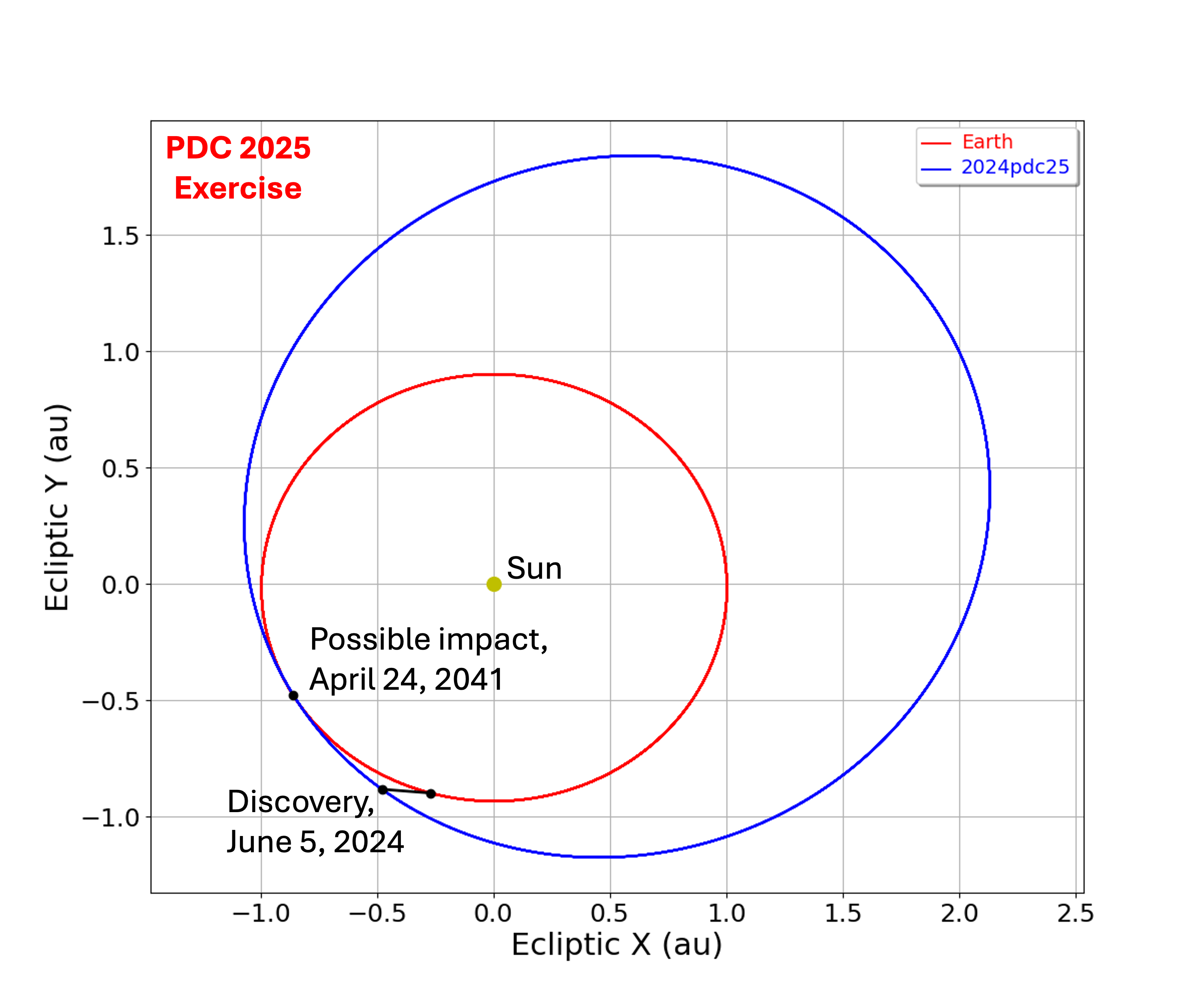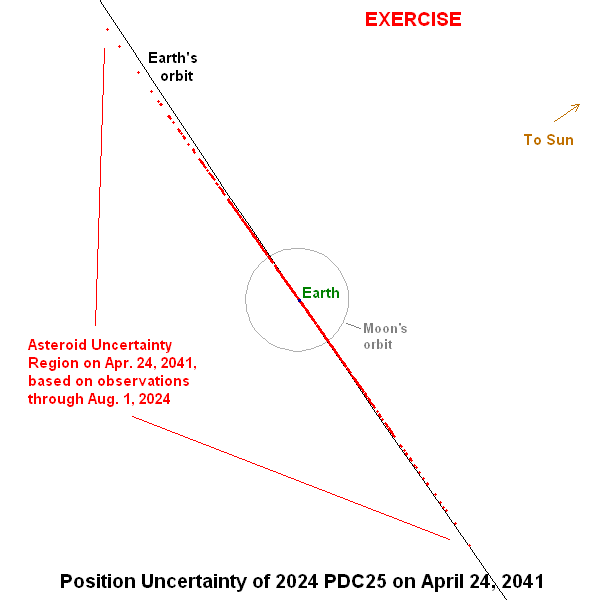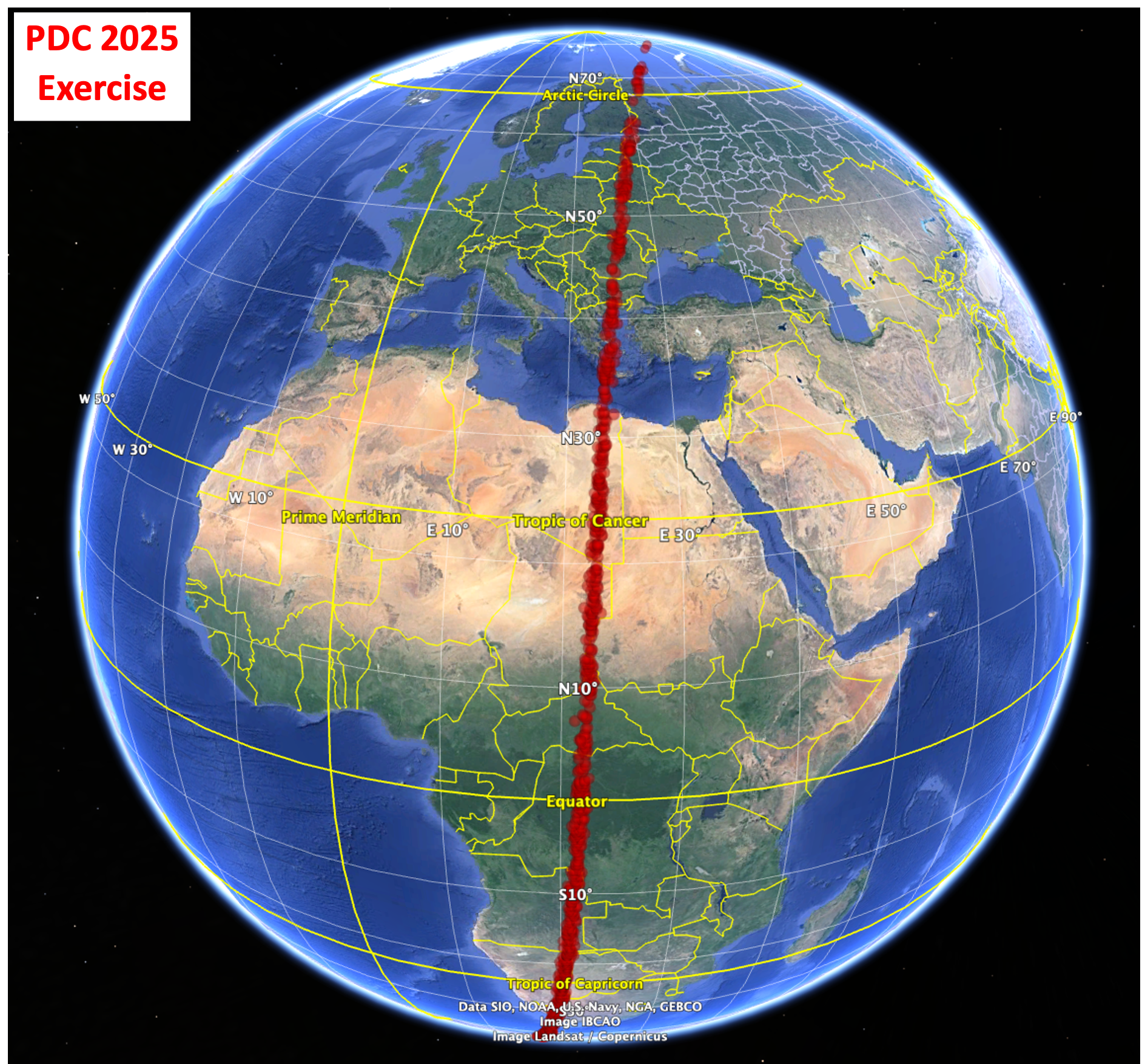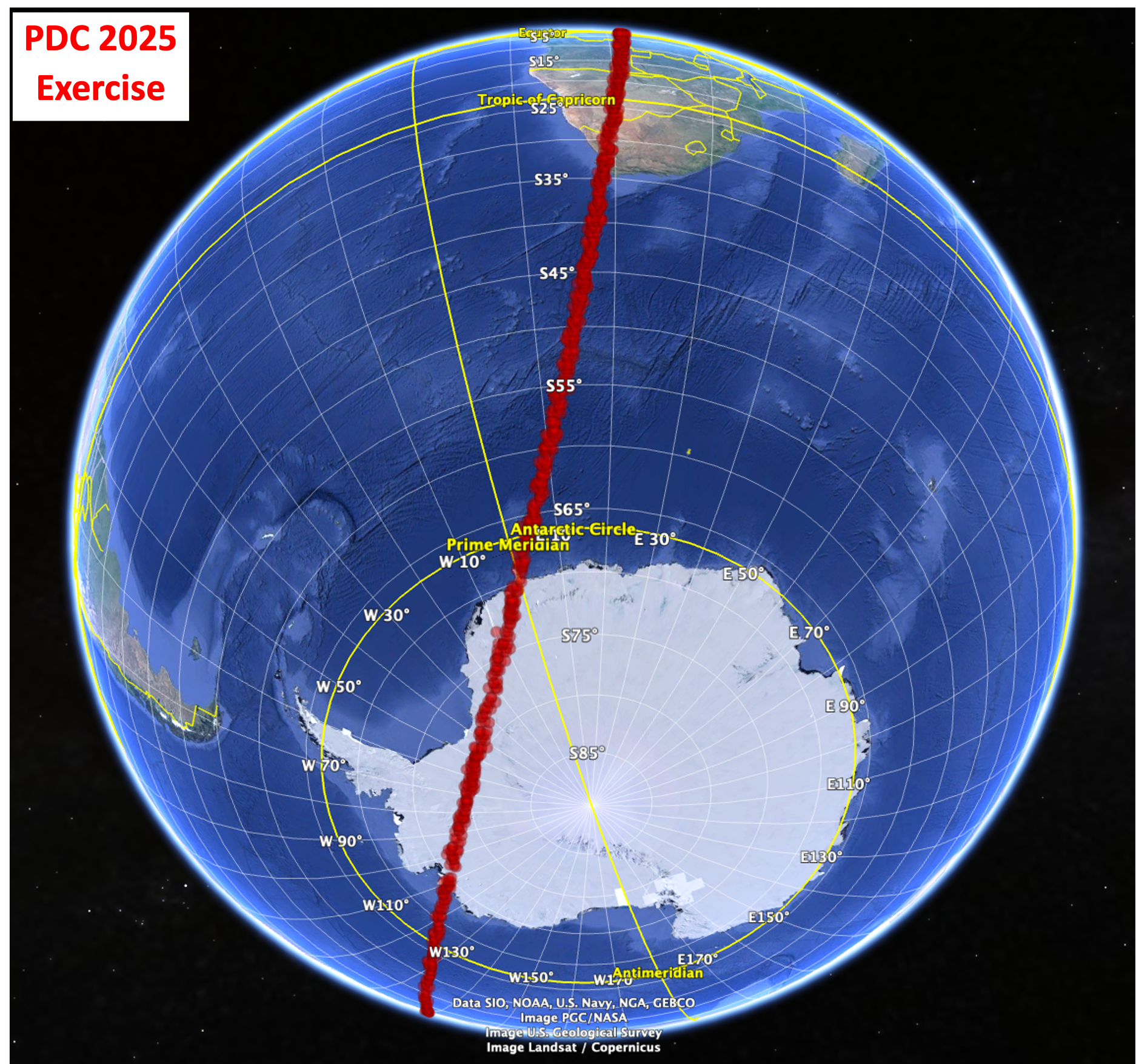



A new near-Earth asteroid is discovered on June 5, 2024 by the Catalina Sky Survey, a program operated by the University of Arizona and funded by NASA. The asteroid was detected at apparent magnitude 21.5, a typical magnitude at which asteroids are discovered in 2024.
The discovery is confirmed by follow-up observations and the discovery is announced by the Minor Planet Center (MPC) the next day. The MPC designates the asteroid as “2024 PDC25.” †
The MPC’s initial assessment reveals that the new asteroid is on an orbit that could approach very close to Earth’s orbit, well within 0.05 au (7.5 million kilometers or 4.6 million miles). (For those who are not familiar with the unit “au”, it stands for “astronomical unit”, which is the mean distance of the Earth from the Sun, 149,597,870.7 km, or 92,955,807 miles.) ††
NASA/JPL’s Center for Near-Earth Object Studies (CNEOS) and ESA’s Near-Earth Objects Coordination Centre (NEOCC) independently compute initial estimates of 2024 PDC25’s orbit and confirm that it approaches very close to Earth’s orbit.
Within a few days of discovery, CNEOS’s Sentry impact monitoring system and NEOCC’s Aegis impact monitoring system independently determine that 2024 PDC25 has a very small, 1-in-ten-thousand chance of impacting Earth in the year 2041. Both organizations post this prediction on their respective Impact Risk webpages. The date of the potential impact is April 24, 2041, nearly 17 years away.
On the Palermo Scale, a measure of an asteroid’s impact threat, the 2041 potential impact of 2024 PDC25 rates -2.0, placing it near the top of the list of impact risks. On the 1-to-10 Torino Scale, however, the asteroid is rated 0.
When first detected, 2024 PDC25 is distant, about 0.233 au (3.5 million kilometers or 2.2 million miles) from Earth. It was recently a bit closer than this, but is now moving away from our planet. It is too distant to be observed by any planetary radar. Furthermore, 2024 PDC25 will not make a close approach to Earth until its potential impact encounter in 2041. The asteroid will, however, remain distantly observable in the nighttime sky, through mid-December 2024, and at many more observation intervals (“apparitions”) between now and 2041.
The orbit of 2024 PDC25 is modestly eccentric, extending from a perihelion (closest-to-Sun) distance of 1.0 au to an aphelion (farthest-from-Sun) distance of 2.29 au. Its orbital period is 774 days (2.1 years). The orbit is inclined about 11 degrees to the Earth’s orbital plane.
Initially, very little is known about 2024 PDC25’s physical properties. Based on measurements of its brightness, the absolute (intrinsic) magnitude of 2024 PDC25 is estimated to be H = 21.9 ± 0.3 and the size estimate is highly uncertain.
Astronomers continue to track 2024 PDC25 almost every night after its discovery. These follow-up observations reduce the uncertainties in the asteroid’s trajectory and the Earth impact probability. The asteroid is quite faint and fading, and will soon require large (2-meter and larger) telescopes.
As the tracking dataset has grown, the orbit of 2024 PDC25 has become more certain, and the estimated chance of impact in 2041 has risen. The probability climbed past 1% in late July, 2024, reaching the IAWN notification threshold. Now, on August 1, 2024, which we refer to as “Epoch 1,” the impact probability is 1.6%. The date of the potential impact date is April 24, 2041, making the “warning time” about 16.5 years.
As of this date, the Palermo Scale rating for 2024 PDC25 has increased to about +0.05, and the Torino Scale rating is now 3 (yellow).
An infrared observation of 2024 PDC25 by the James Webb Space Telescope (JWST) was successfully obtained, providing an important measurement of the asteroid’s size. As a result, the asteroid’s size is estimated to be most likely in the range 90 - 160 meters (300 - 520 feet), with a median size of 125 meters (410 feet), and the full range of the possible sizes is estimated to be 50 - 280 meters (160 - 920 feet). The JWST observation also indicated that the asteroid belongs to the S-type taxonomic class.
Based on the range of possible Earth impact velocities of 2024 PDC25 in 2041 and its estimated size and taxonomy, the energy released at impact is estimated to be most likely in the range 5 - 70 Mt, but possibly as large as 720 Mt. The expected damage of the impacts could be on the regional scale, likely extending as far as 110 kilometers from the impact location (which is not yet known) but possibly as far as 200 kilometers.
The uncertainty in the level of impact damage is mostly due to uncertainty in the asteroid size.
The following diagram shows the orbits of 2024 PDC25 and Earth, along with their positions when the asteroid was discovered on June 5, 2024, and the point where the two orbits intersect, which is where the potential impact would occur. In this view, both the Earth and asteroid orbit the Sun in a counter-clockwise direction; the asteroid makes nearly 8 revolutions about the Sun between discovery and the potential impact, while the Earth makes roughly 17 revolutions over that interval.

|
| Orbit of asteroid 2024 PDC25 |

|
| Current uncertainty in predicted position of asteroid 2024 PDC25 on April 24, 2041 |
As 2024 PDC25 is observed over subsequent months and years, its orbit will become better determined and the predicted uncertainty region in 2041 will shrink. If the Earth remains within the region as it shrinks, the impact probability will increase; if the Earth falls outside the region as it shrinks, the impact probability will drop to zero.
At epoch 1, 2024 PDC25’s uncertainty region for the time of the potential impact is hundreds of times longer than the diameter of the Earth, but its width is only about a hundred kilometers. When the Earth sweeps through this uncertainty region, it intersects a small portion of it, producing what is called a “risk corridor” across the surface of the Earth. This corridor, indicated by the red dots in the following two Google Earth images, indicates the possible locations where the asteroid might impact. The corridor wraps more than halfway around the globe, slicing across Eastern Europe, the Mediterranean Sea, through central Africa to the Cape of Good Hope, across the South Atlantic to the Antarctic coast near the Antarctic Peninsula, and then into the South Pacific. The asteroid cannot impact outside of this risk corridor. These images were produced by filling the uncertainty region in space with thousands of random-sample cases and then propagating these cases forward to impact.

|
| Risk corridor for 2024 PDC25 - Northern portion |

|
| Risk corridor for 2024 PDC25 - Southern portion |
A Google Earth kml file for these impact points is available.
A table of the impact circumstances of 345 potential impact points evenly spaced along the central axis of 2024 PDC25’s risk corridor is available. The columns of this table are as follows:
xi & zeta are the Opik b-plane coordinates of the trajectory, in km
Lat & ELon are the latitude and East longitude of the impact point, in degrees
Vel is the impact velocity in km/s
Az & El are the azimuth (measured eastwards from North) and elevation of the incoming velocity vector, in degrees
Time is the UTC time of the impact on the impact date, 2041-Apr-24.
The red dots tracing the risk corridor are randomly distributed within the region. While there are gaps between the points shown here, the risk corridor is in fact a continuous region, in which the impact probability is proportional to the average areal density of the points. The points become more widely spaced towards the end of the corridor because the asteroid enters at shallower elevation angles in those regions.
Impact probability is estimated from an asteroid’s orbit and its uncertainty. The orbit, in turn, is computed from the available astrometric (sky-position) observations and their uncertainties. So far, 2024 PDC25 has been tracked for less than two months, and only about a hundred astrometric observations are in the dataset. Those observations are provided in the Astrometry Data Exchange Standard (ADES) format.
Further observations of 2024 PDC25 will be possible over the next 4 to 5 months, but they will then cease because the asteroid will move too close to the daytime sky to be imaged. The asteroid will remain unobservable from Earth until late in August, 2025, when it will return close enough to the nighttime sky. When those August 2025 observations become available, the impact probability will likely change dramatically, either rising to nearly 100% certainty if the asteroid is in fact on an impact trajectory, or, more likely, falling to near-zero if the asteroid is not on an impact trajectory.
Plots are available to provide details about the observability conditions of 2024 PDC25 from the ground.
The physical properties of 2024 PDC25 were constrained by the JWST observation, but they are still quite uncertain. A physical properties file containing 5000 instantiations spanning the current distributions of possible properties of this asteroid at epoch 1 is provided along with the description of the columns in the file.
A special version of the JPL orbit viewer is available for this object.
A Google Earth maps KMZ file of damage risk swath and sample damage footprints, along with a document outlining the contents of the file is available.
The orbit for a worst-case trajectory for 2024 PDC25 has been loaded into JPL’s HORIZONS system, and can be accessed via the name “2024 PDC25” or “PDC25”. The trajectory is worst-case in the sense that it passes closest to the geocenter, where it would require the most deflection in order to miss the Earth compared to other possible trajectories closer the limbs. In other words, this is the trajectory that impacts the encounter b-plane closest to the center of the Earth disc, as described below. HORIZONS can be accessed with this object preloaded via the web-interface.
For those who wish to use SPICE Toolkit software to examine the trajectory of 2024 PDC25, an SPK file has been created for the same “worst-case” orbit described above, and is available here: https://ssd.jpl.nasa.gov/ftp/xfr/2024_PDC25/2024_PDC25-s1-merged-DE441.bsp
The SPK file is consistent with and contains additional DE441 planetary ephemeris information over the time span 1998-Jan-01 through impact on 2041-Apr-24, permitting retrieval of object state vectors at any arbitrary instant within that timespan.
This same worst-case trajectory for 2024 PDC25, described above, has been loaded into the JPL/Aerospace Corp. NEO Deflection App. This online tool allows users to study the velocity change (delta-v) required to deflect the 2024 PDC25 trajectory away from the Earth, as a function of deflection time. A specific amount of impulsive velocity change can be applied at a specific time before impact and the resulting deflection in the impact b-plane is shown. The app can also be configured to calculate kinetic impactor spacecraft trajectories, as well as the maximum spacecraft masses that can be launched onto those trajectories by various launch vehicles. The app calculates the delta-v applied to the asteroid when one or more of those kinetic impactors hits it, as a function of asteroid size, density and momentum enhancement factor beta, and determines the Opik b-plane coordinates, xi and zeta, of the deflected trajectory during the 2041 encounter. A complete description of how to use the app is available.
Trajectories for other PDC scenarios, such as that for the 2019 PDC, are also loaded into the app.
† Following usual protocol, the designation begins with “2024”, the year the asteroid was discovered. To reinforce the fact that this is not a real asteroid, however, we are using three letters in the designation, something that would never be done for an actual asteroid. Trailing digits are often used at the end of designations to make them unique, and for this hypothetical object we append “25” to the designation to reflect the year of the Planetary Defense Conference at which the exercise will be discussed.
†† The 0.05 au theshold on the closeness of the two orbits is one of the criteria for an asteroid to be considered “potentially hazardous”. The other criterion is asteroid size, and since the preliminary estimate is that 2024 PDC25 is probably larger than 140 meters in size, this asteroid qualifies as a Potentially Hazardous Asteroid (PHA).